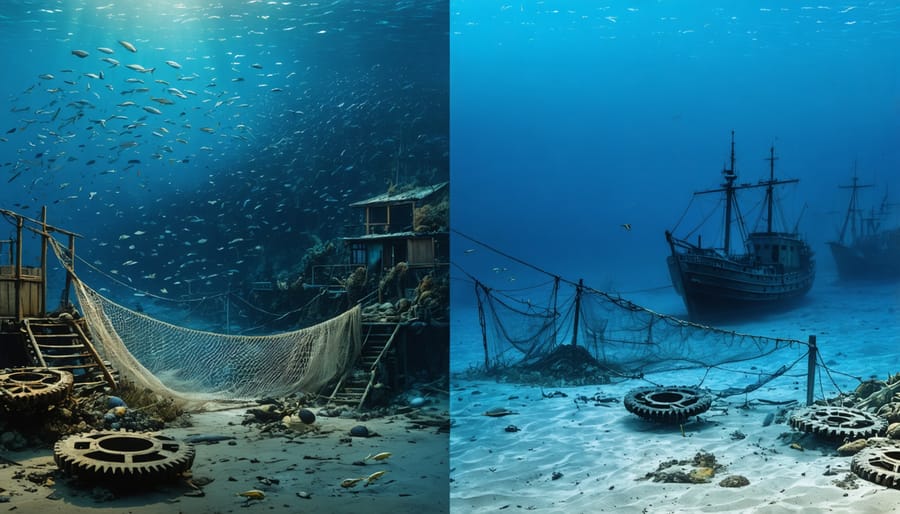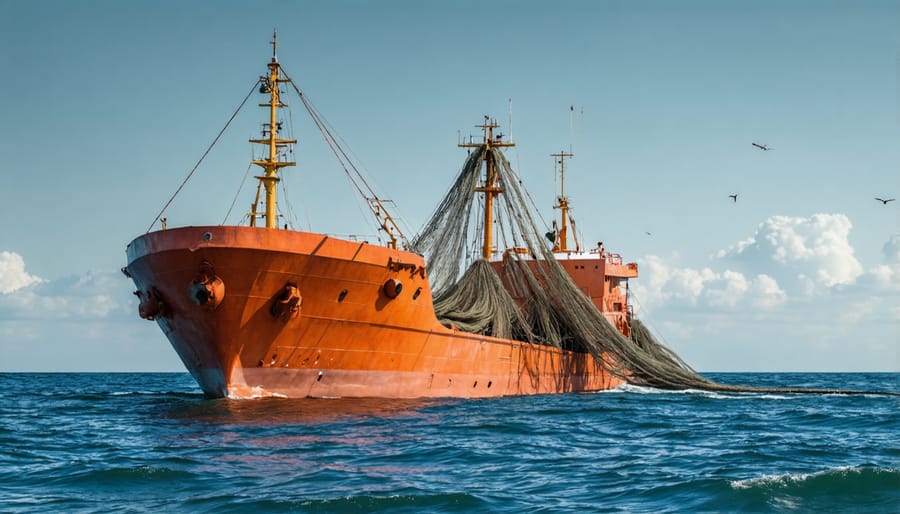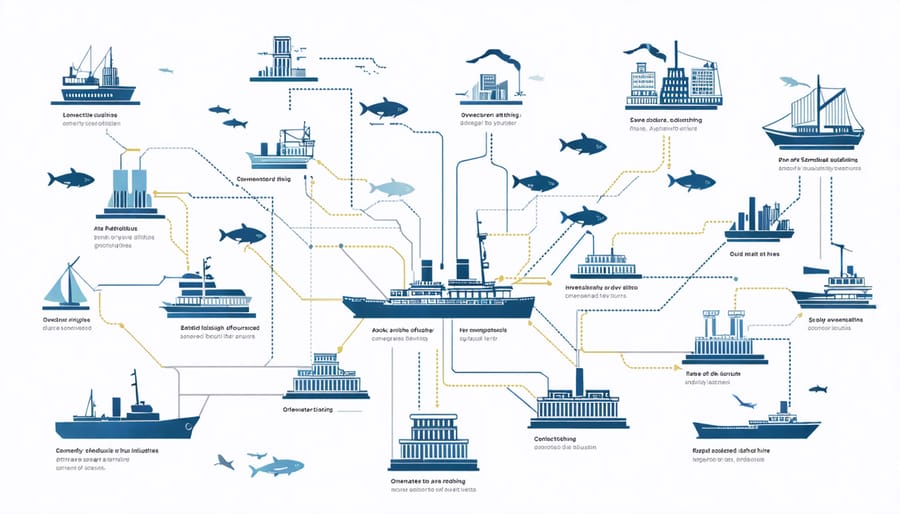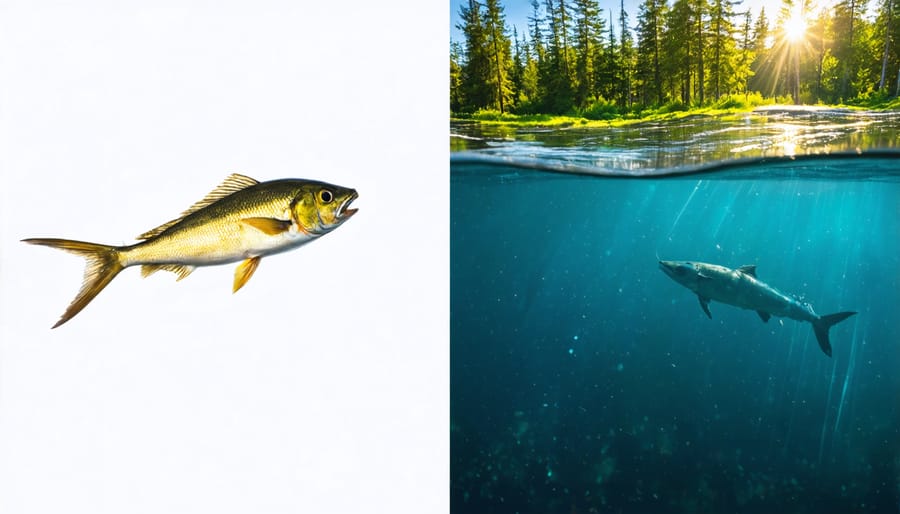The Hidden Price of Empty Oceans: How Overfishing is Crushing Global Economies

The devastating impact of overfishing extends far beyond depleted fish populations, threatening the economic stability of coastal communities worldwide and disrupting a global seafood industry valued at over $400 billion annually. As marine ecosystems collapse under the pressure of industrial fishing fleets, we’re witnessing a dramatic ripple effect: thousands of fishing-dependent communities face unemployment, seafood processing plants shut down, and tourism sectors dependent on vibrant marine life struggle to survive. The consequences reach deep into national economies, with developing countries particularly vulnerable as they lose billions in potential export revenue and food security. This crisis represents not just an environmental catastrophe but a pressing economic challenge that demands immediate action from policymakers, industry leaders, and consumers alike. The intersection of marine conservation and economic sustainability has never been more critical, as the choices we make today will determine the fate of both ocean ecosystems and the millions of people whose livelihoods depend on them.
The Direct Economic Losses
Job Losses and Industry Collapse
The economic toll of overfishing extends far beyond the water’s edge, devastating coastal communities and traditional fishing livelihoods. In recent years, numerous fishing-dependent regions have experienced significant job losses, with an estimated 5.6 million fishers facing unemployment or severe income reduction worldwide. Small-scale fishing operations, often family-owned businesses passed down through generations, have been particularly vulnerable to closure.
Consider New England’s cod fishing industry, once a cornerstone of the regional economy. Following the collapse of cod stocks in the 1990s, over 34,000 jobs were lost, and countless family businesses shuttered their operations permanently. Similar scenarios have played out globally, from the North Sea’s herring fisheries to Southeast Asia’s tuna industry.
The ripple effects touch adjacent sectors as well. Processing plants, equipment manufacturers, and local suppliers have experienced sharp declines in business activity. In many coastal communities, restaurants and tourism businesses that relied on fresh, local seafood have struggled to maintain profitability with increasingly scarce and expensive fish supplies.
Recovery efforts face significant challenges, as depleted fish populations can take decades to rebuild. However, some communities have found success through diversification into sustainable aquaculture or eco-tourism. These transitions, while challenging, demonstrate how communities can adapt while protecting marine resources for future generations.

Revenue Decline in Commercial Fishing
The commercial fishing industry has experienced significant financial downturn in recent decades, with global revenues declining by an estimated $36 billion annually due to depleted fish populations. Recent data from the Food and Agriculture Organization (FAO) indicates that 34% of global fishing operations are now operating at a loss, compared to just 14% in the 1970s.
The North Atlantic cod fishery collapse serves as a stark example of this decline. Following its collapse in the early 1990s, over 35,000 fishers and plant workers lost their jobs, resulting in economic losses exceeding $2 billion. Similar patterns are emerging worldwide, with the Mediterranean Sea reporting a 75% decrease in fishing revenue over the past 25 years.
Small-scale fishing communities have been hit particularly hard. In Southeast Asia, where fishing provides livelihoods for millions, average fishing household incomes have dropped by 50% since 2000. This decline has forced many fishers to either abandon their traditional profession or resort to more destructive fishing practices in desperate attempts to maintain their income.
The economic ripple effects extend beyond direct fishing revenues. Processing plants, boat manufacturers, and fishing equipment suppliers have reported substantial losses, with an estimated 15% of related businesses closing in the past decade. These closures have particularly impacted coastal communities, where alternative employment opportunities are often limited.
Ripple Effects Across Industries

Tourism and Recreation Impacts
The impact of overfishing extends far beyond commercial fishing operations, significantly affecting coastal tourism and recreational fishing industries. Many coastal communities rely heavily on marine-based tourism, with activities like sport fishing, snorkeling, and diving contributing substantially to local economies. When fish populations decline, these activities become less attractive to visitors, leading to reduced tourism revenue.
Recreational fishing, a multi-billion dollar industry, has experienced particular strain due to overfishing. In many regions, declining fish populations have led to stricter regulations and shorter fishing seasons, directly impacting charter boat operations, fishing equipment retailers, and associated businesses. For example, some popular sport fishing destinations have seen up to 30% reduction in tourism revenue when target species become scarce.
The degradation of marine ecosystems caused by overfishing also affects dive tourism. Healthy coral reefs and abundant marine life are major attractions for diving enthusiasts, but when fish populations diminish, these underwater landscapes become less diverse and appealing. This reduction in marine biodiversity has forced some diving operations to relocate or close entirely, causing economic ripples throughout coastal communities.
Coastal hotels, restaurants, and other tourism-dependent businesses also feel the effects when fishing-related tourism declines. Many establishments that traditionally served fresh, local seafood must either import fish at higher costs or modify their menus, potentially losing their unique appeal to tourists. This transformation not only impacts individual businesses but can alter the cultural identity of entire coastal communities that have historically been centered around abundant marine resources.
Supply Chain Disruptions
The ripple effects of overfishing extend far beyond the water’s edge, creating significant disruptions throughout the entire seafood supply chain. Processing facilities, which traditionally operated at full capacity, now face irregular supply patterns and extended periods of inactivity. This inconsistency leads to reduced work hours for employees and increased operational costs as facilities struggle to maintain efficiency with diminished input.
Distribution networks, carefully optimized for predictable seafood volumes, are experiencing unprecedented challenges. Trucking companies and cold storage facilities must adapt to erratic supply patterns, often operating below capacity while still bearing fixed costs. This inefficiency has led to higher transportation costs per unit, ultimately affecting consumer prices and market accessibility.
The retail sector faces particularly acute challenges, with supermarkets and restaurants struggling to maintain consistent seafood offerings. Many establishments have been forced to modify their menus or seek alternative protein sources, impacting their business models and customer relationships. The uncertainty in supply has made effective marine resource management crucial for maintaining stable business operations.
Small-scale fish markets and specialized seafood retailers often bear the heaviest burden, as their business models typically rely on specific species that may become scarce or commercially extinct. These businesses must either adapt by diversifying their offerings or risk closure, leading to job losses and reduced economic activity in coastal communities.
The cumulative effect ripples through associated industries, including packaging manufacturers, ice producers, and equipment suppliers, creating a multiplier effect that impacts regional economies. This interconnected chain of disruptions emphasizes the need for sustainable fishing practices to ensure long-term economic stability across all sectors.
Global Economic Consequences
International Trade Implications
The global seafood trade has been significantly impacted by overfishing, creating ripple effects throughout international markets and economic partnerships. Annual international trade in fish and fish products exceeds $160 billion, making it one of the most valuable food commodities traded globally. However, declining fish stocks have begun to strain long-established trading relationships and economic agreements between nations.
Many developing coastal nations, which traditionally relied on fishing exports as a primary source of foreign exchange, are experiencing severe economic pressure. For instance, West African countries have seen their fishing revenues decline by over 40% in recent decades, forcing them to renegotiate trading terms with major importing nations like the European Union and China.
The scarcity of certain fish species has led to significant price increases in international markets, affecting both export revenues and import costs. Premium species like bluefin tuna have seen price increases of over 200% in the past decade, transforming them from everyday meals to luxury items in many markets.
This situation has also sparked new international tensions over fishing rights and access to remaining stocks. Countries are increasingly implementing stricter regulations and quota systems, while some have resorted to illegal fishing practices to maintain their market share. These developments have led to the emergence of new trade barriers and the modification of existing free trade agreements to include more stringent sustainability requirements.
Food Security Challenges
The depletion of fish stocks through overfishing poses significant challenges to global food security, particularly in coastal communities and developing nations where fish serves as a primary protein source. As fish populations decline, the availability of this crucial protein becomes increasingly limited, forcing communities to seek alternative food sources that are often more expensive or less nutritious.
In many developing regions, fish provides up to 50% of the total animal protein consumed, making it an essential component of nutritional security. The reduced availability of fish protein has led to increased reliance on imported food products, straining national economies and household budgets. This shift not only impacts dietary habits but also creates economic pressure on vulnerable populations who must allocate more resources to meet their nutritional needs.
The ripple effects extend beyond immediate food security concerns. As communities transition away from traditional fish-based diets, there’s increased pressure on terrestrial food production systems, leading to higher prices for alternative protein sources. This economic burden disproportionately affects low-income households and can contribute to nutritional deficiencies in populations that historically relied on seafood.
Local markets and food distribution systems also face disruption when fish supplies become unreliable. Small-scale vendors and processors, many of whom are women in developing countries, experience reduced income and economic instability. This creates a cycle of economic hardship that affects entire communities and their ability to maintain food security.

Solutions and Economic Opportunities
The path toward economic recovery and ocean health lies in implementing sustainable fishing practices that can generate long-term prosperity while protecting marine ecosystems. Research shows that allowing fish populations to recover could increase fishing industry profits by $53 billion annually, creating a win-win situation for both the environment and the economy.
Several successful initiatives demonstrate the viability of sustainable solutions. Marine Protected Areas (MPAs) have proven particularly effective, with studies showing that fish populations in protected zones can increase by up to 400% within a decade. These protected areas serve as nurseries for fish populations, eventually leading to spillover effects that benefit nearby fishing grounds.
Catch share programs have also shown promising results. In Alaska, the halibut fishery’s transition to catch shares has extended the fishing season from 3 days to 8 months, dramatically improving both safety and profitability. Similar programs in New Zealand and Iceland have led to increased catch values and reduced operating costs.
Technology plays a crucial role in sustainable fishing solutions. Advanced monitoring systems, including satellite tracking and electronic reporting, help prevent illegal fishing while reducing operational costs. Innovative fishing gear designs minimize bycatch, ensuring target species are caught more efficiently while protecting endangered species.
The transition to sustainability also creates new economic opportunities. Eco-tourism centered around marine conservation generates substantial revenue, while sustainable seafood certification programs command premium prices in the market. Investment in aquaculture research and development offers another avenue for meeting global seafood demand while reducing pressure on wild fish stocks.
Local fishing communities worldwide are discovering that conservation and economic success can go hand in hand. For instance, in the Philippines, community-managed marine reserves have increased fish catches by 50% while creating new jobs in eco-tourism and marine protection.
The economic impact of overfishing extends far beyond the immediate depletion of fish stocks, creating a complex web of consequences that affect coastal communities, global food security, and international trade relationships. Throughout this exploration, we’ve seen how unsustainable fishing practices lead to job losses, reduced tourism revenue, and destabilized marine ecosystems that support billions in economic activity worldwide.
However, there is hope on the horizon. Successful case studies from countries like Norway and New Zealand demonstrate that implementing sustainable fishing practices can revitalize marine populations while maintaining profitable fishing industries. These examples show that when governments, fishing communities, and consumers work together, we can create lasting positive change.
To move forward, we must embrace several key solutions: implementing science-based catch limits, supporting the transition to sustainable fishing gear, establishing more marine protected areas, and strengthening international cooperation on fishing regulations. Individual consumers can contribute by making informed seafood choices and supporting businesses that prioritize sustainable fishing practices.
The time for action is now. By investing in sustainable fishing practices today, we can secure the future of both marine ecosystems and the communities that depend on them. Whether you’re a policymaker, fishing industry professional, or conscious consumer, your choices matter. Together, we can transform the fishing industry into a model of environmental stewardship while ensuring its continued economic viability for generations to come.
